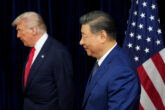December 13, 2022
The Right Time For Chip Export Controls
On Oct. 7, the U.S.-China tech competition heated up dramatically when the Biden administration imposed wide-ranging semiconductor-related export controls on China. While there has been plenty of discussion of the extraordinary scope and scale of the controls, less attention has been paid to their timing.
Why did the Biden administration choose to impose these controls now? And why did the Biden team act when it did? Did the United States squander future leverage over China’s artificial intelligence (AI) and weapons development efforts? What was the trade-off considered between acting unilaterally now and spending more time to get allies on board? The question of “Why now?” is an important one, because it has direct bearing on whether these policies will be both effective (that is, by preventing the items and services from going to China) and not counterproductive (that is, by not helping foreign competitors of U.S. companies affected).
Convincing allies to follow suit on manufacturing equipment restrictions is imperative, as controls will be broader and have greater impact when executed in tandem with the Netherlands and Japan.
The Department of Commerce’s Bureau of Industry and Security (BIS) published a rule with five main parts. One part banned any entity or individual from supplying leading-edge graphics processing units (GPUs)—a type of integrated circuit that accelerates the creation of images—and electronics containing them to any other entity or individual in China. These controls were imposed because GPU chips play an important role in the development and use of artificial intelligence applications, particularly the deep learning methods that are the main driver of the current AI boom. This ban applies to all foreign-made GPUs as a result of a modified extraterritorial jurisdictional rule called the foreign direct product rule, or FDPR for short. The new FDPR subjects any such chip made directly from American technology or software, or produced, even in part, from U.S.-made semiconductor production equipment to U.S. jurisdiction.
Read the full article from Lawfare.
More from CNAS
-
Transatlantic Security / Technology & National Security
Look Before We Leap on Artificial IntelligenceThis article was originally published on The Dispatch. A debate about the role that artificial intelligence should and will play in society, and how it will affect humanity fo...
By Jon B. Wolfsthal
-
Technology & National Security
Caleb Withers on the Cybersecurity Frontier in the Age of AICaleb Withers, research associate at the Center for a New American Security, joins Kevin Frazier, the AI Innovation and Law Fellow at the University of Texas School of Law and...
By Caleb Withers
-
Technology & National Security
Prepared, Not ParalyzedExecutive Summary The Trump administration has embraced a pro-innovation approach to artificial intelligence (AI) policy. Its AI Action Plan, released July 2025, underscores t...
By Janet Egan, Spencer Michaels & Caleb Withers
-
Indo-Pacific Security / Technology & National Security
Sharper: Tech + ChinaRecent talks between President Donald Trump and Chinese Communist Party General Secretary Xi Jinping placed a spotlight on emerging technologies, from high-end chips to minera...
By Charles Horn & Sevi Silvia




